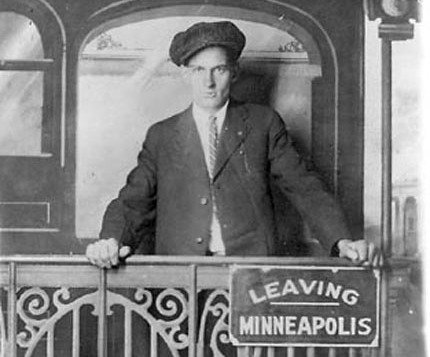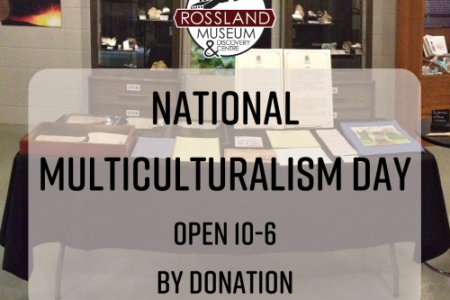TALES AND LEGENDS OF THE MOUNTAIN KINGDOM: Arthur “Slim” Evans forms Local 480 in Rossland
Just when I thought I’d uncovered every exciting personality to ever grace the streets of Rossland back in the day, I happened to make a spur of the moment trip to a rather well known Vancouver used book store, famous for not only its crammed shelves, but its crammed aisles, nooks, and crannies as well. I’m talking about MacLeod’s Books, which, if you haven’t been there before, is quite the experiential book shopping affair.
There are books literally everywhere; it looks like a hurricane just landed itself in this old, high-ceilinged space and deposited books in whatever space it could find–on shelves, on the floor (which needs a good vacuuming), everywhere. Despite the apparent chaos, it’s fairly well organized, and the elderly men who run the place know where everything is. I’d been there before and knew where to find Kootenay history books I lucked out and found one whole book on the history of Trail. It’s an old, out of print copy of Elsie Turnbull’s Trail Between Two Wars: The Story of a Smelter City. Back in its day, it sold for $6 (the original price tag is still on it); I paid $5 and felt slightly ripped off.
Anyway, it’s a pretty interesting little book, and upon glancing through it in the store, I could tell there were bits of Rossland-relevant information in it, and when I brought it home and read it, I considered the $5 well spent.
So the topic at hand this time around is a subject close to the hearts of many in BC and in Rossland-Trail area: unionism. Rossland was no union newbie back in the Depression years of the 1930s, because, as we know, the miners had a union and a nice strike back in 1901. By the 1930s, however, mining in Rossland was pretty much done, and the community was now a bedroom town for the workers of the Trail smelting operation, then called the Consolidated Mining & Smelting Company of Canada. It would later on become Cominco, and is now known as Teck.
The 1930s were a bleak time both worldwide and locally; the Great Depression had a firm grip on the economy and unemployment was rampant. The smelter in Trail managed to keep itself productive, however, by diversifying its business model, and until the latter half of the 1930s the workforce was pretty content and hadn’t mobilized itself into any unions. Instead, manager Selwyn G. Blaylock had the Workmen’s Committee he consulted with. In 1937, it became a guaranteed right that workers could organize in BC, and events from outside the Kootenays threw things into a virtual tizzy.
Enter Arthur “Slim” Evans, a Toronto born hard core union dude who was sent to Trail by the International Union of Mine, Mill, and Smelter Workers, who were hell-bent on unionizing all miners and smelter workers in BC.
Slim was born in 1890 and left school at the age of 13 to help support his family by selling newspapers, driving a team of horses, and doing other odd jobs. He left Ontario at the age of 21, moving west and working first as a farmer, then as a carpenter. He did a stint in the States, in Minneapolis, and became a member of the Industrial Workers of the World, who had the unfortunate nickname of the “Wobblies.” He got shot during a strike in Colorado, which forever left him with a limp.
Slim came back to Canada and led, for a time, the One Big Union (what was eventually to become the Canadian Labour Congress) coal miners’ local in Drumheller, Alberta, but spent three years in jail for leading a strike there. He did another 18 month stint in jail for leading a coal miners’ strike in Princeton. He had also joined the Communist Party of Canada when it formed in 1921, and became an organizer in the BC chapter.
But Slim’s big claim to fame came in 1935, when he led the On-to-Ottawa trek, which, if you know your Canadian history, was kind of a big deal. Organized by communists who had organized relief work camp workers into the Relief Camp Workers’ Union, the trek started in Vancouver on June 3, 1935 with the relief workers taking to the rails in boxcars bound for Ottawa. With stops points east of Vancouver including Kamloops, Golden, and Calgary, by the time the boxcars reached Saskatchewan, there were over 2000 relief workers involved in the trek.
A delegation, led by Slim, met with then Prime Minister, R.B. Bennett, AKA the “Iron Heel.” The meeting did not go well, heated words were exchanged, and Bennett stopped the trek in its literal tracks in Regina. It would go no further. But that wasn’t the end; on July 1, Regina’s city police were ordered by the Prime Minister to arrest the trek’s organizers, including Slim, and, armed with guns, clubs, and tear gas, instigated the Regina Riot. Slim escaped jail time due to lack of evidence, and two years later, he ended up in Trail, in a boarding house on Bay Street, trying to unionize the smelter workers of the C.M. & S. Co.
But he didn’t start his business in Trail; he started it in Rossland with a small group of communists there. Quietly, through word of mouth, he set up a meeting at the Orwell Hotel in town, and 10 members signed up to charter the Local 480 of the International Union of Mine, Mill, and Smelter Workers. They began a campaign to oust the C.M. & S. Co.’s Workers Committee.
The Orwell Hotel is now known as the Flying Steamshovel.
After a few months of hanging out, Slim claimed to have signed 1000 workers up for the 480. He held a huge rally, had his car stolen and torched–and blamed it on the smelter’s management. Then he was caught drunk driving on Columbia Avenue and was put in the jail, where he caused a serious ruckus and was sentenced to a seven day term.
This soured his relations with his bosses at the Congress of Industrial Organization, which was affiliated with International Union of Mine, Mill, and Smelter Workers. He resigned his position and left the Trail-Rossland area in a bit of disgrace.
He was killed after being hit by a car in Vancouver, on February 13, 1944.
The Local 480 still exists, only now it belongs to the union of United Steel Workers. This union also had its roots in the Congress of Industrial Organization, and had locals at Stelco, in Hamilton, and in other parts of Ontario as well.
Sources:
Trail Between Two Wars: The Story of a Smelter City, by Elsie G. Turnbull
http://en.wikipedia.org/wiki/Arthur_%22Slim%22_Evans
http://esask.uregina.ca/entry/evans_arthur_slim_1890-1944.html
http://socserv.mcmaster.ca/oldlabourstudies/onlinelearning/uswacda/uswahistory/uswamain.htm


























